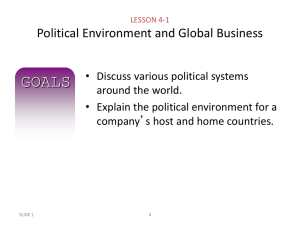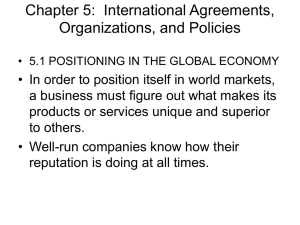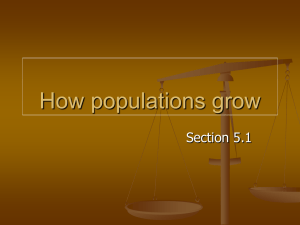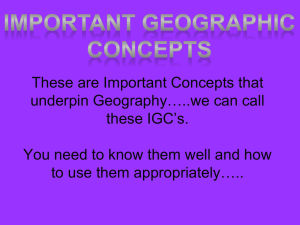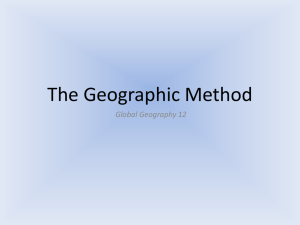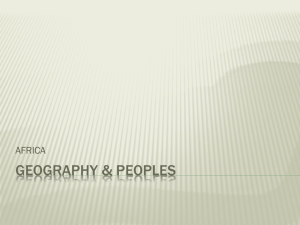Worldwide Product Structure
advertisement
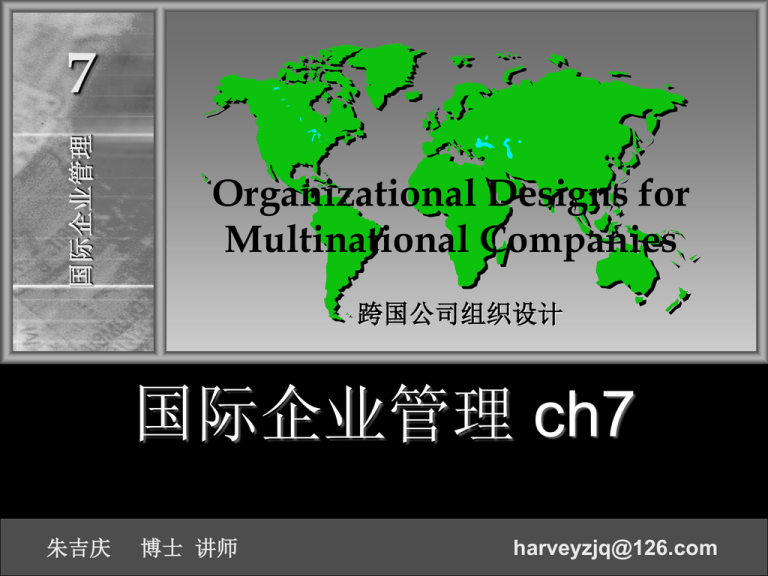
国际企业管理 7 Organizational Designs for Multinational Companies 跨国公司组织设计 国际企业管理 ch7 朱吉庆 博士 讲师 harveyzjq@126.com Learning Objectives • Understand the components of organizational design • Know the basic building blocks of organization structure • Understand the structural options for multinational companies • Know the choices multinationals have in the use of subsidiaries 国际企业管理 跨国公司组织设计 7–2 Learning Objectives • See the links between multinational strategies and structures • Understand the basic mechanisms of organizational coordination and control • Know how coordination and control mechanisms are used by multinational companies • Understand the need for knowledge management systems within organizations 国际企业管理 跨国公司组织设计 7–3 Organizational Design • How organizations structure subunits and coordination and control mechanisms to achieve strategic goals • Basic questions: - How to divide work among the organization’s subunits? - How to coordinate and control the efforts of the units created? 国际企业管理 跨国公司组织设计 7–4 Nature of Organization Design • In small organizations, there is little reason to divide work - Everyone does the same thing and everything • As organizations grow, there is a need to divide work and the organization • There is no one best organizational design 国际企业管理 跨国公司组织设计 7–5 The Basic Functional Structure • Departments perform separate business functions such as marketing or manufacturing • Simplest of organizations • Most smaller organizations have functional structures 国际企业管理 跨国公司组织设计 7–6 Exhibit 8.1: A Basic Functional Structure 国际企业管理 跨国公司组织设计 7–7 The Basic Functional Structure • Works best when organization has: - Few products Few locations Few types of customers A stable environment Routine technology 国际企业管理 跨国公司组织设计 7–8 The Basic Product and Geographic Structures • Product structure: departments or subunits based on different product groups • Geographic structure: departments or subunits based on geographic regions 国际企业管理 跨国公司组织设计 7–9 The Basic Product and Geographic Structures (cont.) • Usually less efficient than the functional organization • Allows a company to serve customer needs that vary by region or product 国际企业管理 跨国公司组织设计 7–10 Exhibit 8.2: Product Structure 国际企业管理 跨国公司组织设计 7–11 Exhibit 8.3: A Basic Geographic Structure 国际企业管理 跨国公司组织设计 7–12 The Basic Product and Geographic Structures • Managers choose product structures when: Product or an area sufficiently unique to require focused functional efforts on one type of product or service • Hybrid structure: mixes functional, geographic, and product units 国际企业管理 跨国公司组织设计 7–13 Organizational Structures to Implement Multinational Strategies • When company first goes international, it seldom changes structure. - Passive exporter • Licensing has little impact on domestic structures. • However, when international sales become more central, structures need to be changed. 国际企业管理 跨国公司组织设计 7–14 Export Department • Coordinates and controls a company’s export operations • Export department - Is created when exports become significant - Deals with international sales of all products 国际企业管理 跨国公司组织设计 7–15 Exhibit 8.4: A Functional Structure with an Export Department 国际企业管理 跨国公司组织设计 7–16 Foreign Subsidiaries • Subunit of the multinational company that is located in another country • Types of foreign subsidiaries - Minireplica subsidiary: smaller version of the parent company Uses the same technology and producing the same products as the parent company - Transnational subsidiary: has no companywide form or function Each subsidiary contributes what it does best 国际企业管理 跨国公司组织设计 7–17 Foreign Subsidiaries • Many subsidiaries are neither minireplicas nor transnationals • May take different forms or functions 国际企业管理 跨国公司组织设计 7–18 Foreign Subsidiaries • Multinationals choose the mix of functions based on: - The firm’s multinational strategy or strategies - The subsidiaries’ capabilities and resources - The economic and political risk of building and managing a subunit in another country - How the subsidiaries fit into the overall multinational organizational structure 国际企业管理 跨国公司组织设计 7–19 International Division • Larger and has greater responsibilities compared to the export department • Responsible for managing exports, international sales, and foreign subsidiaries • Usual step after export department • Deals with all products • Manages overseas sales force and manufacturing sites 国际企业管理 跨国公司组织设计 7–20 Exhibit 8.5: An International Division 国际企业管理 跨国公司组织设计 7–21 Organizational Structures to Implement Multinational Strategies • Reasons to abandon the international division - Diverse products overwhelm capacities of multinational - Not close enough to local markets - Cannot take advantage of global economies of scale or global sources of knowledge 国际企业管理 跨国公司组织设计 7–22 Organizational Structures to Implement Multinational Strategies • Several options available to deal with these shortcomings - Worldwide product structure Worldwide geographic structure Matrix structure Transnational-network structure 国际企业管理 跨国公司组织设计 7–23 Worldwide Geographic Structure • Has geographical units representing regions of the world - Prime reason is to implement a multidomestic or regional strategy - Organizational design with maximum geographic flexibility - Separate divisions for large market countries 国际企业管理 跨国公司组织设计 7–24 Exhibit 8.6: Royal Vopak Geographic Structure 国际企业管理 跨国公司组织设计 7–25 Worldwide Product Structure • Worldwide product structure - Gives product divisions responsibility to produce and sell their products or services throughout the world - Implements strategies that emphasize global products - Provides an efficient way to organize and centralize the production and sales of similar products 国际企业管理 跨国公司组织设计 7–26 Exhibit 8.7: Worldwide Product Structure 国际企业管理 跨国公司组织设计 7–27 Hybrids • Both worldwide product structure and worldwide geographic structure have advantages and disadvantages - Product structure: supports global products - Geographic structure: emphasizes local adaptation • Multinationals often want both abilities • Use hybrids 国际企业管理 跨国公司组织设计 7–28 Front-back Hybrid Structure • The front side has units based on geography to provide a multidomestic or regional focus • The backside has units based on product groups to capture global economies of scale in R&D and production 国际企业管理 跨国公司组织设计 7–29 Exhibit 8.8: Tetra Pak’s Front-Back Hybrid Structure 国际企业管理 跨国公司组织设计 7–30 Worldwide Matrix Structures • Symmetrical organization with equal emphasis on - Worldwide product groups and - Regional geographical divisions • Geographic divisions focus on national responsiveness and product divisions focus on finding global efficiencies 国际企业管理 跨国公司组织设计 7–31 Worldwide Matrix Structures • Balances the benefits produced by area and product structures • Creates equal lines of authority for products and areas - Works best with near equal demands from both sides • Requires extensive resources for communication and coordination • Requires middle and upper level managers with good human relations skills 国际企业管理 跨国公司组织设计 7–32 Exhibit 8.9: Worldwide Matrix Organization 国际企业管理 跨国公司组织设计 7–33 Matrix Structures • Problems emerging with worldwide matrix structures - Slow decision making process - Too bureaucratic - Too many meetings and too much conflict 国际企业管理 跨国公司组织设计 7–34 Matrix Structures (cont.) • Result - Some companies have abandoned their matrixes and returned to product structures - Other companies have redesigned their matrix structures to be more flexible with speedier decision making 国际企业管理 跨国公司组织设计 7–35 The Transnational-Network Structure • Newest solution to the complex demand of being locally responsive and taking advantage of global economies of scale • Combines functional, product, and geographic subunits - Dispersed subunits - Specialized operations - Interdependent relationships 国际企业管理 跨国公司组织设计 7–36 The Transnational-Network Structures • Has no symmetry or balance in its structural form • Resources, people, and ideas flow in all directions • Nodes or centers in the network coordinate product, functional, and geographic information 国际企业管理 跨国公司组织设计 7–37 The Transnational-Network Structures • Philips divides the world into three groups Key countries: such as the Netherlands and the United States produce for local and world markets and control local sales Large countries: such as Mexico and Belgium have some local and worldwide production facilities and local sales Local business countries: smaller countries that are primarily sales units and that import products from the product divisions’ worldwide production centers in other countries 国际企业管理 跨国公司组织设计 7–38 Exhibit 8.10: Geographic Links in the Philips Transnational Structure 国际企业管理 跨国公司组织设计 7–39 Exhibit 8.11: Product Links in the Same Organization 国际企业管理 跨国公司组织设计 7–40 Components of the TransnationalNetwork Structure 1.Dispersed subunits: subsidiaries located anywhere where they can most benefit the company 2.Specialized operations: subunits specializing in particular product, research areas, or marketing areas 3.Interdependent relationships: continuous sharing of information and resources by dispersed and specialized subunits 国际企业管理 跨国公司组织设计 7–41 Metanational Structure • Large entrepreneurial multinational Can tap into pockets of innovation, technology, and markets located around the world • Develops extensive systems to encourage organizational learning and entrepreneurial activities 国际企业管理 跨国公司组织设计 7–42 Metanational Characteristics • Nonstandard business formulas for any local activity • Looking to emerging markets as sources of knowledge and ideas • Creating a culture supporting global learning • Extensive use of strategic alliances to gain knowledge for varied sources 国际企业管理 跨国公司组织设计 7–43 Characteristics of Metanationals • High levels of trust between partners to encourage knowledge sharing • Centerless organization that moves strategic functions away from headquarters to major markets • Decentralization of decision making to managers who serve key customers and strategic partners 国际企业管理 跨国公司组织设计 7–44 Micro-Multinational Company • Micro-multinational companies: smaller organizations that take advantage of the Web to operate globally from Day One 国际企业管理 跨国公司组织设计 7–45 Micro-Multinational Company • Characteristics - They operate as born-global firms from the day they are founded, and they operate everywhere around the world - They are willing to start operations and hire workers from around the world and from where it makes the most sense to do so - They are more likely to use various state-of-the-art technology for communication purposes 国际企业管理 跨国公司组织设计 7–46 Multinational Strategy and Structure: An Overview • Most companies support early internationalization efforts with export department • Depending on globalization strategy, they evolve into product or geographic structure • Pressure for local adaptation and global efficiencies result into matrix or transnationalnetwork • No company reaches any pure form—use hybrids 国际企业管理 跨国公司组织设计 7–47 Exhibit 8.12: Multinational Strategy, Structure, and Evolution 国际企业管理 跨国公司组织设计 7–48 Control Systems • Control system: helps link the organization vertically, up and down the organizational hierarchy • Basic functions of control system - Measure or monitor the performances of subunits - Provide feedback to subunit managers regarding the effectiveness of their units 国际企业管理 跨国公司组织设计 7–49 Coordination Systems • Coordination system: horizontal organizational links - Provide information flows among subsidiaries 国际企业管理 跨国公司组织设计 7–50 Design Options for Control Systems • Four types of control systems - Output control system Bureaucratic control system Decision-making control Cultural control system 国际企业管理 跨国公司组织设计 7–51 Output Control Systems • Assesses the performance of a unit based on results, not on the processes used to achieve these results - Profit center: unit controlled by its profit or loss performance 国际企业管理 跨国公司组织设计 7–52 Bureaucratic control system • Focuses on managing behaviors within the organization - Budgets: financial targets for expenditures - Statistical reports: information to top management about nonfinancial outcomes - Standard operating procedures (SOPs): rules and regulations of appropriate behavior 国际企业管理 跨国公司组织设计 7–53 Control and Coordination Systems • Decision-making control: level in the organizational hierarchy where managers have the authority to make decisions • Cultural control system: uses organizational culture to control behaviors and attitudes of employees 国际企业管理 跨国公司组织设计 7–54 Exhibit 8.13: Use of Control Mechanisms in Multinational Organizational Structures 国际企业管理 跨国公司组织设计 7–55 Design Options for Coordination Systems • Textual communication: e-mail, memos, and reports • Direct contact: face-to-face interaction of employees • Liaison roles: part of a person’s job in one department to communicate with people in another department • Task forces: temporary teams created to solve a particular organizational problem • Full-time integrators: cross-unit coordination is the main job responsibility 国际企业管理 跨国公司组织设计 7–56 Teams • Teams: permanent unit of the organization - Global virtual teams: groups of people from different parts of the world who work together by using information and communication technologies such as intranets, web meetings, WIKI’s, e-mails and instant messaging 国际企业管理 跨国公司组织设计 7–57 Problems with Global teams • Team members’ native languages are different • Differences in cultural background • Global teams dominated by headquarters’ perspectives and experiences • Major challenges in building team collaboration • Challenges in meeting programmatic objectives 国际企业管理 跨国公司组织设计 7–58 Steps to ensure the global teams collaborate to function effectively • Build relationships and trust • Devote significant attention to project planning and hold project progress meetings regularly • Cultural, language, and active-listening training • Be aware of team-development stage 国际企业管理 跨国公司组织设计 7–59 Knowledge Management • Knowledge management: refers to the systems, mechanisms, and other design elements of any organization to ensure that the right form of knowledge is available to the right individual at the right time 国际企业管理 跨国公司组织设计 7–60 Knowledge Management • Types of knowledge Explicit form:found in records or other repositories of information Tacit knowledge: represents the knowledge that usually resides within employees and is dependent on the organization’s culture and context 国际企业管理 跨国公司组织设计 7–61 Exhibit 8.14: Knowledge Management Barriers 国际企业管理 跨国公司组织设计 7–62 Knowledge Management: Steps to Develop Successful System • Identify/support knowledge activists • Make knowledge management part of the general strategy • Provide financial and human resources support • Emphasize importance of communication • Celebrate success 国际企业管理 跨国公司组织设计 7–63 Conclusion • Good strategies do not guarantee success – also need good implementation • Need the right organizational designs to carry out strategies • Chapter reviews basic organizational structures and discusses international organizational designs and structures • Chapter also discusses knowledge management systems 国际企业管理 跨国公司组织设计 7–64

